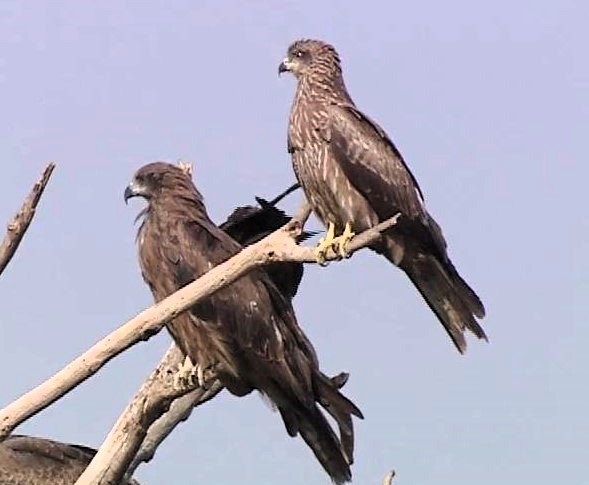Black Kite -Milvus migrans
- The polytypic ‘Migrans group’ of the Genus Milvus may consist of a number of subspecies, Milvus migrans migrans, Milvus migrans govinda, Milvus migrans affinis, Milvus migrans Iineatus, Milvus migrans formosanus, milvus migrans aegyptus and Milvus migrans parasitus.
- The Black kite is a medium sized bird of prey in the family Accipitridae which also includes many diurnal raptors and is regarded as one of the world’s most abundant species of Accipitridae.
- The bird is about 44-66 cms. in length with a wingspan of 120 to 153 cms. The Females weighing 750 to 1080 gms. are generally larger than the males which may weigh 630-980 gms.
- They are opportunistic hunters and spend most of their time soaring and gliding on thermals in search of food.
- It has a black curved beak for tearing flesh.
- The angled wing and distinctive forked tail makes it easy to identify.
- They are very vociferous with a shrill whistle.
- These are also classed as diurnal, carnivores, scavengers, arboreal, predators, gliders, congregatory, oviparous, soaring birds, social, monogamous, flocking and partially migrant.
- Black kites are found in Europe, Asia, Africa and Australia. European and Central Asian birds are migratory, moving to the tropics in winter. Populations in warmer region are resident.
- Inhabit a range of habitats. Frequent in large cities. However, they try to avoid dense forests and high mountains.
- As carnivores and scavengers, Black kites feed on fish, small mammals, birds, bats and rodents. They also consume house hold refuse and carrion.
- They are monogamous and form strong pair bonds often lasting for life. They nest singly or in loose groups using the nests built in trees, cliff ledges or buildings in subsequent years also. Both the sexes take equal part in nest building, incubation and care of chicks. A typical clutch is composed of 2 to 3 eggs and the incubation period varies from 30 to 34 days. Nestlings may stand on their legs after 17-19 days and start flapping their wings after 27-31 days. They may start moving to adjacent branches after 50 days and may start breeding after the second year.
- According to the IUCN Red list, Black kites are classified as least concern and their numbers are stable.
©Srimaa Communication
Acknowledgements-Dr. Yashpal Singh, Mrs. Neena Singh, Mr. Rajesh Bedi, Manoj Kumar Yadav
